Born 20 Feb 1945.
George Fitzgerald Smoot III is an American astrophysicist and cosmologist who studied the cosmic microwave background and discovered the signature of gravitational waves. These ripples in space-time were first predicted by Albert Einstein. They come from the very earliest moments of the cosmos and provide the first direct evidence of the inflation after the Big Bang creation of the universe. Smoot led a research team to map the earliest stages of the cosmos, discovering (1992) a pattern of minuscule temperature variations which evolved into the universe as now formed. He shared the 2006 Nobel Prize for Physics with John C. Mather of NASA Goddard Space Flight Center, “for their discovery of the blackbody form and anisotropy of the cosmic microwave background radiation.”«
George Fitzgerald Smoot III is an American astrophysicist and cosmologist who studied the cosmic microwave background and discovered the signature of gravitational waves. These ripples in space-time were first predicted by Albert Einstein. They come from the very earliest moments of the cosmos and provide the first direct evidence of the inflation after the Big Bang creation of the universe. Smoot led a research team to map the earliest stages of the cosmos, discovering (1992) a pattern of minuscule temperature variations which evolved into the universe as now formed. He shared the 2006 Nobel Prize for Physics with John C. Mather of NASA Goddard Space Flight Center, “for their discovery of the blackbody form and anisotropy of the cosmic microwave background radiation.”«
Wrinkles in Time: Witness to the Birth of the Universe, by George Smoot. - book suggestion.

Born 20 Feb 1937.
German biochemist who, along with Johann Deisenhofer and Hartmut Michel, received the Nobel Prize for Chemistry in 1988 for their determination of the three-dimensional structure of a protein complex that is essential to photosynthesis in bacteria.
German biochemist who, along with Johann Deisenhofer and Hartmut Michel, received the Nobel Prize for Chemistry in 1988 for their determination of the three-dimensional structure of a protein complex that is essential to photosynthesis in bacteria.
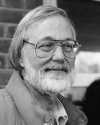
Born 20 Feb 1931.
American mathematician who was awarded the Fields Medal in 1962 for his his proof that a 7-dimensional sphere can have 28 different differential structures. This work opened up the new field of differential topology. Milnor's theorem shows that the total curvature of a knot is at least 4 . In the 1950's, Milnor did a substantial amount of work on algebraic topology in which he constructed the classifying space of a topological group and gave a geometric realisation of a semi-simplicial complex. Since the 1970's his interest is in dynamics, especially holomorphic dynamics. Milnor served the American Mathematical Society as vice president (1975-76) and was awarded the Wolf Prize in 1989.
. In the 1950's, Milnor did a substantial amount of work on algebraic topology in which he constructed the classifying space of a topological group and gave a geometric realisation of a semi-simplicial complex. Since the 1970's his interest is in dynamics, especially holomorphic dynamics. Milnor served the American Mathematical Society as vice president (1975-76) and was awarded the Wolf Prize in 1989.
American mathematician who was awarded the Fields Medal in 1962 for his his proof that a 7-dimensional sphere can have 28 different differential structures. This work opened up the new field of differential topology. Milnor's theorem shows that the total curvature of a knot is at least 4
Topology from the Differentiable Viewpoint, by John Willard Milnor. - book suggestion.
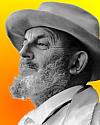
Born 20 Feb 1902; died 22 Apr 1984 at age 82.
American photographer and environmentalist whose compelling images of the American landscape were matched by his dedication to the conservation of those lands. His love began as a child on a family vacation in Yosemite National Park (1916) with the Kodak Box Brownie camera his parents had given him. By 1920 he had joined the Sierra Club and before long was contributing photographs to the Sierra Club Bulletin. On 10 Apr 1927 he created his first masterpiece, Monolith: The Face of Half Dome showing Yosemite's most striking feature. He turned to a career in commercial photography. While on the Sierra Club board of directors (1934-71) he helped lobby to save the great wilderness shown in his photographs.«
American photographer and environmentalist whose compelling images of the American landscape were matched by his dedication to the conservation of those lands. His love began as a child on a family vacation in Yosemite National Park (1916) with the Kodak Box Brownie camera his parents had given him. By 1920 he had joined the Sierra Club and before long was contributing photographs to the Sierra Club Bulletin. On 10 Apr 1927 he created his first masterpiece, Monolith: The Face of Half Dome showing Yosemite's most striking feature. He turned to a career in commercial photography. While on the Sierra Club board of directors (1934-71) he helped lobby to save the great wilderness shown in his photographs.«
America's Wilderness: The Photographs of Ansel Adams With the Writings of John Muir, by Ansel Adams et al. - book suggestion.
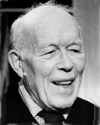
Born 20 Feb 1901; died 20 Feb 1982 at age 81. quotes
René (Jules) Dubos was a French-born American microbiologist, environmentalist, and author who pioneered research in isolating antibacterial substances from certain soil microorganisms and the discovery of major antibiotics. In 1938, he discovered ribonuclease, a simple 3D enzyme, but an early contribution to research on the most basic functions of life. In 1939, Dubos showed that a soil bacterium was capable of decomposing the starchlike capsule of the pneumococcus bacterium, rendering it harmless - unable to cause pneumonia. From the soil microbe Bacillus brevis, he isolated tyrothricin, that was highly toxic to a wide range of bacteria. Other research included acquired immunity, tuberculosis, and bacteria of the gastrointestinal tract. He died on his birthday.
René (Jules) Dubos was a French-born American microbiologist, environmentalist, and author who pioneered research in isolating antibacterial substances from certain soil microorganisms and the discovery of major antibiotics. In 1938, he discovered ribonuclease, a simple 3D enzyme, but an early contribution to research on the most basic functions of life. In 1939, Dubos showed that a soil bacterium was capable of decomposing the starchlike capsule of the pneumococcus bacterium, rendering it harmless - unable to cause pneumonia. From the soil microbe Bacillus brevis, he isolated tyrothricin, that was highly toxic to a wide range of bacteria. Other research included acquired immunity, tuberculosis, and bacteria of the gastrointestinal tract. He died on his birthday.
Rene Dubos, Friend of the Good Earth, by Carol L. Moberg. - book suggestion.
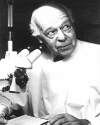
Born 20 Feb 1894; died 21 Dec 1988 at age 94.
American psychobiologist who discovered the body's biorhythms and identified the part of the brain that controls daily cycles of sleeping, waking and other activities. He first wrote about this biological clock in a 1927 paper in which he described how internal cycles control an animal's drinking, eating, running, and sexual behaviour. He also studied the great extent to which animal biological processes can be modifed by learned behaviour. Richter connected the discovery of fire by ancient peoples to significant modifications in habits, communication, learning and even resulted in changes in brain structure. He related behaviour and the biochemistry of sleep, stress, and the onset of disease. Altogether Richter wrote over 250 research papers.«
American psychobiologist who discovered the body's biorhythms and identified the part of the brain that controls daily cycles of sleeping, waking and other activities. He first wrote about this biological clock in a 1927 paper in which he described how internal cycles control an animal's drinking, eating, running, and sexual behaviour. He also studied the great extent to which animal biological processes can be modifed by learned behaviour. Richter connected the discovery of fire by ancient peoples to significant modifications in habits, communication, learning and even resulted in changes in brain structure. He related behaviour and the biochemistry of sleep, stress, and the onset of disease. Altogether Richter wrote over 250 research papers.«
Biological clocks in medicine and psychiatry, by Curt Paul Richter. - book suggestion.
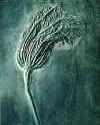
crinoid
Born 20 Feb 1892; died 16 Apr 1974 at age 82.
American paleontologist known for his work on Paleozoic crinoids, bryozoans, and corals (invertebrate organisms existing 570 to 245 million years ago). Crinoids are stalked echinoderms (spiny-skinned, exclusively marine organisms), almost extinct today, related to sea stars. Fossil stemmed forms, sometimes called "sea lilies," have a superficial resemblance to flowers, but were animals. Moore is probably best known as the founder and editor of the landmark multi-volume Treatise of Invertebrate Paleontology.
American paleontologist known for his work on Paleozoic crinoids, bryozoans, and corals (invertebrate organisms existing 570 to 245 million years ago). Crinoids are stalked echinoderms (spiny-skinned, exclusively marine organisms), almost extinct today, related to sea stars. Fossil stemmed forms, sometimes called "sea lilies," have a superficial resemblance to flowers, but were animals. Moore is probably best known as the founder and editor of the landmark multi-volume Treatise of Invertebrate Paleontology.
Invertebrate Fossils, by Raymond C. Moore. - book suggestion.
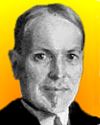
Born 20 Feb 1873; died 18 Jul 1946 at age 73.
American psychologist who was a leader adopting the scientific method in the study and reform of education. His own research included the nature and development in reading, language, number ideas and their development, writing, and the higher mental processes. He examined the psychological issues of school curriculum and the pedagogical methods used in education. He believed an overarching educational objective was to developing the learner's social consciousness, rather than the expression of an individual's instinct, but to participate in a cooperative social experience. He filed an affidavit at the Scope's trial in strong support of the teaching of evolution in schools.«
American psychologist who was a leader adopting the scientific method in the study and reform of education. His own research included the nature and development in reading, language, number ideas and their development, writing, and the higher mental processes. He examined the psychological issues of school curriculum and the pedagogical methods used in education. He believed an overarching educational objective was to developing the learner's social consciousness, rather than the expression of an individual's instinct, but to participate in a cooperative social experience. He filed an affidavit at the Scope's trial in strong support of the teaching of evolution in schools.«
The Evolution of a Democratic School System, by Charles Hubbard Judd. - book suggestion.
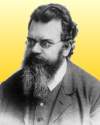
Born 20 Feb 1844; died 5 Sep 1906 at age 62. quotes
Austrian physicist who founded statistical mechanics. After obtaining his doctorate, he became an assistant to his teacher Josef Stefan. Boltzmann's fame is based on his invention of statistical mechanics, independently of Willard Gibbs. Their theories connected the properties and behaviour of atoms and molecules with the large scale properties and behaviour of the substances of which they were the building blocks. He also worked out a kinetic theory of gases, and the Stefan-Boltzmann law concerning a relationship between the temperature of a body and the radiation it emits. His firm belief and defense of atomism (that all matter is made of atoms) against hostile opposition to this new idea, may have contributed to his suicide in 1906.
Austrian physicist who founded statistical mechanics. After obtaining his doctorate, he became an assistant to his teacher Josef Stefan. Boltzmann's fame is based on his invention of statistical mechanics, independently of Willard Gibbs. Their theories connected the properties and behaviour of atoms and molecules with the large scale properties and behaviour of the substances of which they were the building blocks. He also worked out a kinetic theory of gases, and the Stefan-Boltzmann law concerning a relationship between the temperature of a body and the radiation it emits. His firm belief and defense of atomism (that all matter is made of atoms) against hostile opposition to this new idea, may have contributed to his suicide in 1906.
Boltzmann's Atom: The Great Debate That Launched A Revolution In Physics, by David Lindley. - book suggestion.
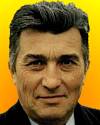
Died 20 Feb 1993 at age 76 (born 28 Apr 1916).
Italian industrialist who founded a luxury car company that produced some of the fastest, most expensive, and sought-after sports cars in the world. Lamborghini worked as a mechanic in the Italian army during World War II, and after the war he started a tractor company.
Italian industrialist who founded a luxury car company that produced some of the fastest, most expensive, and sought-after sports cars in the world. Lamborghini worked as a mechanic in the Italian army during World War II, and after the war he started a tractor company.
Lamborghini: Forty Years, by David Jolliffe. - book suggestion.

Died 20 Feb 1982 at age 81 (born 20 Feb 1901). quotes
René (Jules) Dubos was a French-born American microbiologist, environmentalist, and author who pioneered research in isolating antibacterial substances from certain soil microorganisms and the discovery of major antibiotics. In 1938, he discovered ribonuclease, a simple 3D enzyme, but an early contribution to research on the most basic functions of life. In 1939, Dubos showed that a soil bacterium was capable of decomposing the starchlike capsule of the pneumococcus bacterium, rendering it harmless - unable to cause pneumonia. From the soil microbe Bacillus brevis, he isolated tyrothricin, that was highly toxic to a wide range of bacteria. Other research included acquired immunity, tuberculosis, and bacteria of the gastrointestinal tract. He died on his birthday.
René (Jules) Dubos was a French-born American microbiologist, environmentalist, and author who pioneered research in isolating antibacterial substances from certain soil microorganisms and the discovery of major antibiotics. In 1938, he discovered ribonuclease, a simple 3D enzyme, but an early contribution to research on the most basic functions of life. In 1939, Dubos showed that a soil bacterium was capable of decomposing the starchlike capsule of the pneumococcus bacterium, rendering it harmless - unable to cause pneumonia. From the soil microbe Bacillus brevis, he isolated tyrothricin, that was highly toxic to a wide range of bacteria. Other research included acquired immunity, tuberculosis, and bacteria of the gastrointestinal tract. He died on his birthday.
Rene Dubos, Friend of the Good Earth, by Carol L. Moberg. - book suggestion.
Died 20 Feb 1980 at age 84 (born 29 Sep 1895).
American parapsychologist.
American parapsychologist.
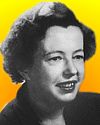
Died 20 Feb 1972 at age 65 (born 28 Jun 1906). quotes
German physicist who shared one-half of the 1963 Nobel Prize for Physics with J. Hans D. Jensen of West Germany for their proposal of the shell nuclear model. (The other half of the prize was awarded to Eugene P. Wigner of the United States for unrelated work.) In 1939 she worked at Columbia University on the separation of uranium isotopes for the atomic bomb project. In 1949, she devised the shell nuclear model, which explained the detailed properties of atomic nuclei in terms of a structure of shells occupied by the protons and neutrons. This explained the great stability and abundance of nuclei that have a particular number of neutrons (such as 50, 82, or 126) and the same special number of protons.
German physicist who shared one-half of the 1963 Nobel Prize for Physics with J. Hans D. Jensen of West Germany for their proposal of the shell nuclear model. (The other half of the prize was awarded to Eugene P. Wigner of the United States for unrelated work.) In 1939 she worked at Columbia University on the separation of uranium isotopes for the atomic bomb project. In 1949, she devised the shell nuclear model, which explained the detailed properties of atomic nuclei in terms of a structure of shells occupied by the protons and neutrons. This explained the great stability and abundance of nuclei that have a particular number of neutrons (such as 50, 82, or 126) and the same special number of protons.
Maria Goeppert Mayer, by Joseph P. Ferry. - book suggestion.
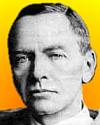
Died 20 Feb 1960 at age 79 (born 17 Apr 1880).
Charles Leonard Woolley was an English archaeologist whose excavation (1922-34) of the ancient Sumerian city of Ur (in modern Iraq), the royal burial site of many Mesopotamian royalties, greatly advanced knowledge of ancient Mesopotamian civilization, enabling scholars to trace the history of the city from its final days during the 4th century BC back to its prehistoric beginnings (c. 4000 BC). His finds revealed much about everyday life, art, architecture, literature, government, and religion in this "cradle of civilization. " In royal tombs dating from about 2700 BC, he uncovered the practice of the sacrificial burial of a deceased king's personal retinue. He discovered tombs of great material wealth, gold and silver jewelry, large paintings of ancient Mesopotamian culture at its zenith, and other furnishings. The most extravagant tomb of Queen Pu-Abi was untouched by the hands of looters through the millennia, with many well-preserved items, including a cylindrical seal bearing her name in Sumerian. His widely read Ur of the Chaldees: A record of seven years of excavation (1929), described his findings in a manner both informative to specialists and accessible by lay-persons.
Charles Leonard Woolley was an English archaeologist whose excavation (1922-34) of the ancient Sumerian city of Ur (in modern Iraq), the royal burial site of many Mesopotamian royalties, greatly advanced knowledge of ancient Mesopotamian civilization, enabling scholars to trace the history of the city from its final days during the 4th century BC back to its prehistoric beginnings (c. 4000 BC). His finds revealed much about everyday life, art, architecture, literature, government, and religion in this "cradle of civilization. " In royal tombs dating from about 2700 BC, he uncovered the practice of the sacrificial burial of a deceased king's personal retinue. He discovered tombs of great material wealth, gold and silver jewelry, large paintings of ancient Mesopotamian culture at its zenith, and other furnishings. The most extravagant tomb of Queen Pu-Abi was untouched by the hands of looters through the millennia, with many well-preserved items, including a cylindrical seal bearing her name in Sumerian. His widely read Ur of the Chaldees: A record of seven years of excavation (1929), described his findings in a manner both informative to specialists and accessible by lay-persons.
Woolley of Ur: The Life of Sir Leonard Woolley, by H. V. F. Winstone. - book suggestion.
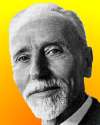
Died 20 Feb 1956 at age 74 (born 2 Dec 1881).
Heinrich Georg Barkhausen was a German physicist who discovered the Barkhausen effect (1919), a principle concerning changes in the magnetic properties of metal. His work in acoustics and magnetism led to the discovery that magnetization affects whole domains of a ferromagnetic material, rather than individual atoms alone. He discovered that a slow, smooth increase of a magnetic field applied to a piece of ferromagnetic material, such as iron, causes it to become magnetized, not continuously but in minute steps. With Karl Kurz, he developed the Barkhausen- Kurz oscillator (1920) for ultrahigh frequencies (forerunner of the microwave tube), leading to understanding of the principle of velocity modulation. He is also known for experiments on shortwave radio transmissions.
Heinrich Georg Barkhausen was a German physicist who discovered the Barkhausen effect (1919), a principle concerning changes in the magnetic properties of metal. His work in acoustics and magnetism led to the discovery that magnetization affects whole domains of a ferromagnetic material, rather than individual atoms alone. He discovered that a slow, smooth increase of a magnetic field applied to a piece of ferromagnetic material, such as iron, causes it to become magnetized, not continuously but in minute steps. With Karl Kurz, he developed the Barkhausen- Kurz oscillator (1920) for ultrahigh frequencies (forerunner of the microwave tube), leading to understanding of the principle of velocity modulation. He is also known for experiments on shortwave radio transmissions.
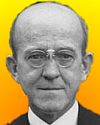
Died 20 Feb 1955 at age 77 (born 21 Oct 1877). quotes
Oswald Theodore Avery was a Canadian-American biochemist and immunologist whose research on pneumococcus bacteria made him one of the founders of immunochemistry. His research laid the groundwork for modern genetics and molecular biology. Avery spent most of his research life at Rockefeller Institute where he made important contributions to the understanding of the pneumococcus organism, a particularly virulent bacterium that caused lobar pneumonia. Prior to Avery's work, genetic material was assumed to be protein. At age 67, Avery made his most important discovery when he proved conclusively that DNA from the nucleus of the cell is the genetic material, in a seminal 1944 paper co-authored by Colin MacLeod and Maclyn McCarty.
Oswald Theodore Avery was a Canadian-American biochemist and immunologist whose research on pneumococcus bacteria made him one of the founders of immunochemistry. His research laid the groundwork for modern genetics and molecular biology. Avery spent most of his research life at Rockefeller Institute where he made important contributions to the understanding of the pneumococcus organism, a particularly virulent bacterium that caused lobar pneumonia. Prior to Avery's work, genetic material was assumed to be protein. At age 67, Avery made his most important discovery when he proved conclusively that DNA from the nucleus of the cell is the genetic material, in a seminal 1944 paper co-authored by Colin MacLeod and Maclyn McCarty.
Oswald Avery and the Story of DNA, by Vesta-Nadine Severs and Jim Whiting. - book suggestion.
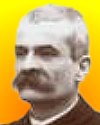
Died 20 Feb 1928 at age 81 (born 19 Jun 1846).
Italian astronomer who was an authority on minor planets. At first a civil engineer, he became an astronomer at the University of Padua (1868-93), with an interest in positional astronomy and made many observations of small planets, comets and star occultations. In 1874, Abetti went to Muddapur, Bengal, to observe the transit of Venus across the sun's disk where his use of a spectroscope was the first use of this kind. Later, he became director at the Arcetri Observatory and Professor of astronomy at the University of Florence (1894-1921). The observatory had been founded by G. B. Donati in 1872, and Abetti equipped it with a new telescope that he had built in the workshops at Padua. He was active after retirement, until his death, and was followed by his son Giorgio.
Italian astronomer who was an authority on minor planets. At first a civil engineer, he became an astronomer at the University of Padua (1868-93), with an interest in positional astronomy and made many observations of small planets, comets and star occultations. In 1874, Abetti went to Muddapur, Bengal, to observe the transit of Venus across the sun's disk where his use of a spectroscope was the first use of this kind. Later, he became director at the Arcetri Observatory and Professor of astronomy at the University of Florence (1894-1921). The observatory had been founded by G. B. Donati in 1872, and Abetti equipped it with a new telescope that he had built in the workshops at Padua. He was active after retirement, until his death, and was followed by his son Giorgio.
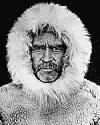
Died 20 Feb 1920 at age 63 (born 6 May 1856).
American polar explorer who made the first successful expedition to the North Pole arriving 6 Apr 1909 with his black assistant Matthew Henson and four Inuit eskimo companions. His claim was disputed by Frederick Cook who claimed to have reached the pole in 1908, a controversy which continues to this day, though most geographers have accepted that Peary was in fact the first to arrive there. He spent several prior years, from 1891, exploring northern Greenland. During one of these expeditions, he discovered what is still known as the largest meterorite. It weighed 90 tons, and is now held by the American Museum of Natural History, N.Y.
American polar explorer who made the first successful expedition to the North Pole arriving 6 Apr 1909 with his black assistant Matthew Henson and four Inuit eskimo companions. His claim was disputed by Frederick Cook who claimed to have reached the pole in 1908, a controversy which continues to this day, though most geographers have accepted that Peary was in fact the first to arrive there. He spent several prior years, from 1891, exploring northern Greenland. During one of these expeditions, he discovered what is still known as the largest meterorite. It weighed 90 tons, and is now held by the American Museum of Natural History, N.Y.
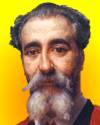
Died 20 Feb 1907 at age 54 (born 28 Sep 1852). quotes
Ferdinand-Frédéric-Henri Moissan was a French chemist who received the 1906 Nobel Prize for Chemistry for the isolation of the highly reactive gaseous element fluorine, and the development of the Moissan electric furnace. In 1884, he began studying fluorine compounds, and separated fluorine two years later when he electrolyzed a solution of potassium fluoride in hydrofluoric acid. Having isolated fluorine, he was then able to determine its physical and chemical properties. From 1892, with an electric arc furnace he designed, Moissan began experimenting with reactions possible at much higher temperatures than before and discovered many new compounds and was able to vaporize substances previously impossible. He developed the furnace for industrial production of acetylene. more
Ferdinand-Frédéric-Henri Moissan was a French chemist who received the 1906 Nobel Prize for Chemistry for the isolation of the highly reactive gaseous element fluorine, and the development of the Moissan electric furnace. In 1884, he began studying fluorine compounds, and separated fluorine two years later when he electrolyzed a solution of potassium fluoride in hydrofluoric acid. Having isolated fluorine, he was then able to determine its physical and chemical properties. From 1892, with an electric arc furnace he designed, Moissan began experimenting with reactions possible at much higher temperatures than before and discovered many new compounds and was able to vaporize substances previously impossible. He developed the furnace for industrial production of acetylene. more
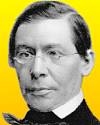
Died 20 Feb 1892 at age 74 (born 30 Oct 1817). quotes
German chemist and historian of chemistry whose studies of the relation of physical properties to chemical structure pioneered physical organic chemistry. Through measurement of boiling point, density, specific heat, and thermal expansion, Kopp showed that differences in the physical properties of organic compounds reflected the degree by which their structure differs.
German chemist and historian of chemistry whose studies of the relation of physical properties to chemical structure pioneered physical organic chemistry. Through measurement of boiling point, density, specific heat, and thermal expansion, Kopp showed that differences in the physical properties of organic compounds reflected the degree by which their structure differs.
Died 20 Feb 1850 at age 49 (born 10 May 1800).
American physician whose popular treatise on birth control, the object of celebrated court actions in the U.S. and England, initiated the widespread use of contraceptives. Anonymously published, his book The Fruits of Philosophy: or The Private Companion of Young Married People was the first on the subject in the U.S. Despite an otherwise appropriate discussion of the medical, social, and economic aspects of birth control, he so offended the public taste of the times that he was prosecuted in the U.S., fined (1832) and imprisoned for three months. In England he was aquitted in what became a famous test case. Subsequently, the book sales rose from 1,000 to 250,000 a year.
American physician whose popular treatise on birth control, the object of celebrated court actions in the U.S. and England, initiated the widespread use of contraceptives. Anonymously published, his book The Fruits of Philosophy: or The Private Companion of Young Married People was the first on the subject in the U.S. Despite an otherwise appropriate discussion of the medical, social, and economic aspects of birth control, he so offended the public taste of the times that he was prosecuted in the U.S., fined (1832) and imprisoned for three months. In England he was aquitted in what became a famous test case. Subsequently, the book sales rose from 1,000 to 250,000 a year.

Died 20 Feb 1841 at age 57 (born 19 Jun 1783).
German chemist who discovered morphine (1806) while trying to isolate the portion of opium that caused sleep. He named the bitter white crystalline alkaloid after Morpheus, the Greek god of dreams.When his initial reports of the drug's properties were challenged, he engaged the help of three friends in test taking the drug themselves. After this delay, the medicinal values of morphine were recognized in his lifetime. Subsequently, Sertürner became insane in mid-life, though he lived to age 57. Morphine is among the most important naturally occurring compounds, being of use in the treatment of pain and other calming effects. Unfortunately, addiction is a possible side effect. Its discovery established alkaloid chemistry.
German chemist who discovered morphine (1806) while trying to isolate the portion of opium that caused sleep. He named the bitter white crystalline alkaloid after Morpheus, the Greek god of dreams.When his initial reports of the drug's properties were challenged, he engaged the help of three friends in test taking the drug themselves. After this delay, the medicinal values of morphine were recognized in his lifetime. Subsequently, Sertürner became insane in mid-life, though he lived to age 57. Morphine is among the most important naturally occurring compounds, being of use in the treatment of pain and other calming effects. Unfortunately, addiction is a possible side effect. Its discovery established alkaloid chemistry.
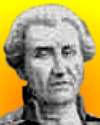
Died 20 Feb 1799 at age 65 (born 4 May 1733).
French mathematician and nautical astronomer noted for his studies of fluid mechanics and his development of instruments for navigation and geodesy, the study of the size and shape of the Earth. Borda joined the navy, took part in several scientific voyages and played a role in the American War of Independence. He was one of the main driving forces in the introduction of the decimal system. Borda made good use of calculus and experiment to unify areas of physics. For his surveying, he also developed a series of trigonometric tables. In 1782, while in command of a flotilla of six French ships, he was captured by the British. Borda's health declined after his release. He is one of 72 scientists commemorated by plaques on the Eiffel tower.
French mathematician and nautical astronomer noted for his studies of fluid mechanics and his development of instruments for navigation and geodesy, the study of the size and shape of the Earth. Borda joined the navy, took part in several scientific voyages and played a role in the American War of Independence. He was one of the main driving forces in the introduction of the decimal system. Borda made good use of calculus and experiment to unify areas of physics. For his surveying, he also developed a series of trigonometric tables. In 1782, while in command of a flotilla of six French ships, he was captured by the British. Borda's health declined after his release. He is one of 72 scientists commemorated by plaques on the Eiffel tower.
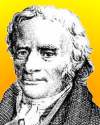
Died 20 Feb 1762 at age 39 (born 17 Feb 1723).
German astronomer who developed lunar tables that greatly assisted navigators in determining longitude at sea. Mayer also discovered the libration (or apparent wobbling) of the Moon. Mayer began calculating lunar and solar tables in 1753 and in 1755 he sent them to the British government. These tables were good enough to determine longitude at sea with an accuracy of half a degree. Mayer's method of determining longitude by lunar distances and a formula for correcting errors in longitude due to atmospheric refraction were published in 1770 after his death. The Board of Longitude sent Mayer's widow a payment of 3000 pounds as an award for the tables.
German astronomer who developed lunar tables that greatly assisted navigators in determining longitude at sea. Mayer also discovered the libration (or apparent wobbling) of the Moon. Mayer began calculating lunar and solar tables in 1753 and in 1755 he sent them to the British government. These tables were good enough to determine longitude at sea with an accuracy of half a degree. Mayer's method of determining longitude by lunar distances and a formula for correcting errors in longitude due to atmospheric refraction were published in 1770 after his death. The Board of Longitude sent Mayer's widow a payment of 3000 pounds as an award for the tables.
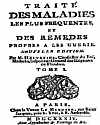
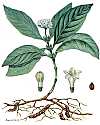
Dutch physician who popularized the use of the ipecacuanha root for its sudorific, expectorant and emetic qualities. A traveller, Le Gras, had brought a quantity of this root from Brazil to Europe in 1672, held by a Parisian apothecary Claquenelle. Helvetius exploited the root extracts successfully as a secret remedy to treat dysentry and diarrhoea. He secured lettres royales from King Louis XIV on 19 July 1688* - a four-year monopoly to sell the drug. The Dauphin - the eldest son of the King and direct heir to the throne - was a grateful patient, cured of an attack of dysentery. On 17 Jan 1708, Helvetius was appointed conseiller du roi as inspector-general of the hospitals in Flanders. He treated cases of dysentery in the King's army.«[Image: Title page of Treaty of the most frequent diseases and of the remedies suitable to cure them by Helvetius; right: ipecac herb]
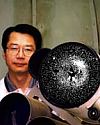
In 1996, a bright “new” star was discovered in Sagittarius by Japanese amateur astronomer Yukio Sakurai. It was found not to be a usual nova, but instead was a star going through a dramatic evolutionary state, re-igniting its nuclear furnace for one final blast of energy called the “final helium flash.” It was only the second to be identified in the twentieth century. A star like the Sun ends its active life as a white dwarf star gradually cooling down into visual oblivion. Sakurai's Object had a mass a few times that of the Sun. Its collapse after fusing most of its hydrogen fuel to helium raised its temperature so much higher it began nuclear fusion of its helium remains. This was confirmed using its light spectrum to identify the elements present.«[Image: star image superimposed on telescope beside Sukarai]

In 1986, the Soviet Union launched into orbit Mir, a new space station. Mir, the Russian word for peace, had six docking ports and special laboratories for scientific research. Weeks later, a veteran crew was sent to man the 56-ft-long and 13.6-ft wide station. The core module provided living quarters for the cosmonauts: galley/table, cooking elements and storage, individual crew cabins and personal hygiene area. They also had a working compartment for monitoring and commanding the core systems supported by an electric power system, thermal control system, computer systems, environmental control and life support, communications and tracking systems. Five additional modules were launched between Mar 1987 and April 1996.[Image: Russia's Mir complex as Shuttle Atlantis approached for docking on 15 Jan 1997]
In 1963, a television receiver and transmitter operated by a laser beam was demonstrated in Bayside, NY. The laser (light amplification by stimulated emission of radion) provides a narrow high-intensity light beam that can be focussed and directed over long distances. The demonstration was made by the General Telephone and Electronics Co.
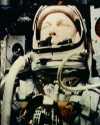
In 1962, John Glenn piloted the Mercury-Atlas 6 Friendship 7 spacecraft on the first U.S. manned orbital mission, launched from Kennedy Space Center, Florida. He made three Earth orbits in about five hours, at altitude up to 162 miles and velocity about 17,500 mph. He saw Perth, Australia, when its residents greeted him by switching on their house lights in unison. A 4-cent stamp put on sale on this launch day became the first U.S. stamp issued on the day of the event it commemorated. Glenn returned to space 36 years later, making 134 more orbits as a crew member of the space shuttle Discovery (29 Oct - 7 Nov 1998) for investigations on space flight and the aging process.«
John Glenn: A Memoir, by John Glenn. - book suggestion.
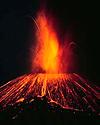
USGS 1946
In 1945, a farmer in his cornfield saw the birth of the Paricutin volcano. Dionisio Pulido was working outside the Tarascan Indian village of Paricutin, Mexico. At about 4 pm, he saw a huge crack on top of a small hill. Although about 150 ft (47m) long by 6 ft (2m) wide, at first it seemed only about a foot (30cm) deep. Then the ground shook with a thundering sound. It erupted with smoke and ash. As its activity continued, blasting out rock and lava, a cinder cone was growing. Within a week it was 165 ft (50m) high. Within months, two evacuated villages were covered with lava. It reached a peak of 1,353 ft (424m) before going dormant in 1953. Scientist studied this young volcano from its birth.«
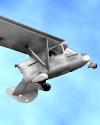
In 1937, the first a successful automobile-airplane combination was complete and ready for testing.The first flight took place the next day, 21 Feb 1937. Built by the Westerman Arrowplane Corporation of Santa Monica, Cal., the vehicle was dubbed the Arrowbile, and claimed a top air-speed of 120 mph and 70 mph on a highway. Designed by aeroengineer Waldo Dean Waterman (1894-1976), it evolved from the prototype Arrowplane, a project to design a simple, easy to fly, low cost airplane. The Studebaker Corporation, which supplied the 100 hp engines, eventually took delivery of five Arrowbiles.
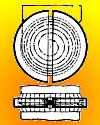
(USPTO)
In 1934, a U.S. patent was issued to Ernest O. Lawrence for his “Method and Apparatus for Acceleration of Ions,” known as the cyclotron (No.1,948,384). He described its operation as “based on the cumulative action of a succession of accelerating impulses wach requiring only a moderate voltage but eventually resulting in an ion speed corresponding to a much higher voltage. The ions are constrained in a circular path in a vacuum chamber by a strong magnetic field while they are accelerated in resonance with oscillations of an electric field.” Spurred by a report by Frédéric Joliot concerning the probability that many elements could become radioactive upon hydrogen ion bombardment, Ernest O. Lawrence applied his invention to bombarding nitrogen in their cyclotron to produce artificial radioactivity.«[Image: diagrammatic elevation (top) and section views of the apparatus.]
An American Genius: The Life of Ernest Orlando Lawrence, by Childs Herbert. - book suggestion.
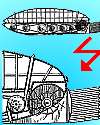
In 1900, John F. Pickering, of Gonaives, Haiti, received a U.S. patent for his design of an air ship or launch (No. 643,975). It combined a "balloon, an attached car carrying a motor and a propeller, fans driven by the motor, air-pipes provided with bent, movable outlets leading both upward and downward from the fans and extending through the balloon and the bottom of the car, and means for shifting the blast of the fan to either upward or downward air-pipes." The operator would also be in control of "the propulsion horizontally or at any desired angle with relation to the horizon ... or the turning of the same to any desired point of the compass."
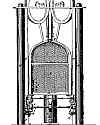
In 1872, Cyrus W. Baldwin received a U.S. patent for a vertical geared hydraulic electric elevator which was installed in the Stephens Hotel hotel in New York City (No. 123,761). The patent described "suspending and operating the elevator carriage from the bottom or platform thereof." Safety devices were included to prevent a fall if the suspending devices should fail. Baldwin also expressed design features to reduce the transfer of sounds to the rest of the building.

In 1872, Luther Childs Crowell, a prolific inventor of Cape Cod, Mass., received a patent for a machine for manufacturing square-bottom paper bags. Patent #123,811 allowed for the bags to have two longitudinal inward folds. As a child, he spent a great deal of time folding pieces of paper, unlike most of his peers who mostly whittled and made things out of wood. In 1867, he took out his first patent for a square-bottom paper bag, and wholesale production began in 1879. It remains the standard paper bag in use throughout the world. Among his 293 patents, other inventions were a bottle-labeling machine, one for folding and wrapping magazines for mailing, and he experimented with an airplane that would be fueled by gunpowder.
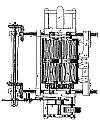
In 1872, Silas Noble and James P. Cooley of Granville, Mass., patented a toothpick manufacturing machine. It was described in patent No. 123,790 as an invention which allows "a block of wood, with little waste and in one operation, [to] be cut up in to toothpicks ready for use." The Noble & Cooley Co. made not only military drums of all sizes, but also toy drums. In 1854, the company produced 631 drums, by 1873 they were manufacturing 100,000 drums a year! Special machinery was designed and built to aid in the difficult process of steam bending, decorating and fabricating the drum parts. The company is now the largest and oldest toy drum manufacturer in America.
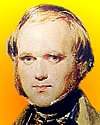
In 1835, Charles Darwin, on his H.M.S. Beagle voyage reached Chile, and experienced a very strong earthquake and shortly afterward saw evidence of several feet of uplift in the region. He repeated measurement a few days later, and found the land had risen several feet. He had proved that geological changes occur even in our own time. Lyell's principles were based on the concept of a steady-state, nondirectional earth whereby uplift, subsidence, erosion, and deposition were all balanced. Thereby, Darwin coupled in his mind this dramatic evidence of elevation with accompanying subsidence and deposition. Thus he hypothesized that coral reefs of the Pacific developed on the margins of subsiding land masses, in the three stages of fringing reef, barrier reef, and atoll.  more
more
From So Simple a Beginning: Darwin's Four Great Books, by Charles Darwin, Edward O. Wilson. - book suggestion.




